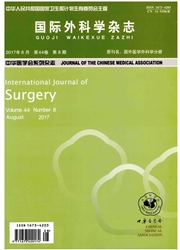

 中文摘要:
中文摘要:
目的 探讨布-加综合征(B-Cs)患者肝内外侧支循环和病理生理分型在选择侵入性治疗策略中的作用.方法 分析1998年3月至2011年10月174例B-CS患者的影像学特征,根据影像学和临床资料进行病理生理分型,制定治疗策略.结果 所有患者均有不同程度肝内外侧支循环的形成.根据侧支循环和临床表现,将患者分为6个亚型.其中12例患者(6.9%)未接受任何侵入性治疗,38例患者行介入治疗,21例患者行手术治疗.103例患者采用分期治疗策略,其中介入治疗61例,手术治疗13例,除一例外均以解除下腔静脉高压(IVCHT)为治疗目的;29例患者接受了二期治疗,其中25例患者同时行介入和手术治疗,4例患者行手术治疗.总体治疗并发症和病死率分别为14.3%和1.1%,而介入治疗并发症和病死率低于手术治疗(4.4%比25.6%,P<0.05).患者平均随访41个月,4例患者接受二期治疗,12例患者接受下腔静脉/主肝静脉(IVC/MHVs)再通.另外,2例患者死于肝细胞肝癌,3例患者死于人工血管血栓形成.结论 根据患者肝内外侧支循环代偿情况制定的病理生理分型能指导B-CS患者治疗策略的选择.对于侧支循环代偿完全的患者不必进行侵入性治疗.只有当病情出现恶化时,才应进行积极治疗.
 英文摘要:
英文摘要:
Objective To assess the role of intra-and extra-hepatic collateral circulations and pathophysiologic classification in the selection of invasive treatment strategy for patients with Budd-Chiari syndrome.Methods Imaging characteristics of 174 adult patients with B-CS managed between March 1998 and October 2011 were analysed.According to the imaging findings and clinical manifestations,a pathophysiologic classification was proposed and different treatment strategies were adopted.The treatment indications and outcomes were prospectively evaluated.Results All patients demonstrated collateral circulations to different extents.Based on the extent of collaterals and clinical data,these patients were classified into six subtypes.Among these patients,12 patients underwent no special treatment (6.9%).38 patients underwent radiological intervention (RI) and 21 patients underwent surgical procedures (SP).A staged treatment strategy was adopted in 103 patients:RI in 61 and SP in 13 were performed for inferior vena cava hypertension (IVCHT) except in one patient the procedure was for portal hypertension (PHT).Twenty-nine patients underwent a second stage treatment:RI and SP in 25 patients and SP in 4 patients.The overall morbidity and mortality after all the procedures were 14.3% and 1.1% respectively.The rates of morbidity and mortality for patients who underwent RI were much lower than those who underwent SP (4.4% vs 25.6%,P 〈 0.05).After a median follow-up of 41 months,4 patients received a second-stage treatment and 12 patients developed recanalization of inferior vena cava or main hepatic veins (IVC/MHVs).In addition,2 patients died of HCC and 3 patients died of graft obstruction.Conclusions Pathophysiologic classification using to the compensatory collateral circulations contributed to the selection of treatment strategies in patients with Budd-Chiari syndrome.No therapy was required for the subgroup of patients who had developed complete compensatory collateral circulations.Treatment sh
 同期刊论文项目
同期刊论文项目
 同项目期刊论文
同项目期刊论文
 Staged management of Budd-Chiari syndrome caused by co-obstruction of the inferior vena cava and mai
Staged management of Budd-Chiari syndrome caused by co-obstruction of the inferior vena cava and mai 期刊信息
期刊信息
